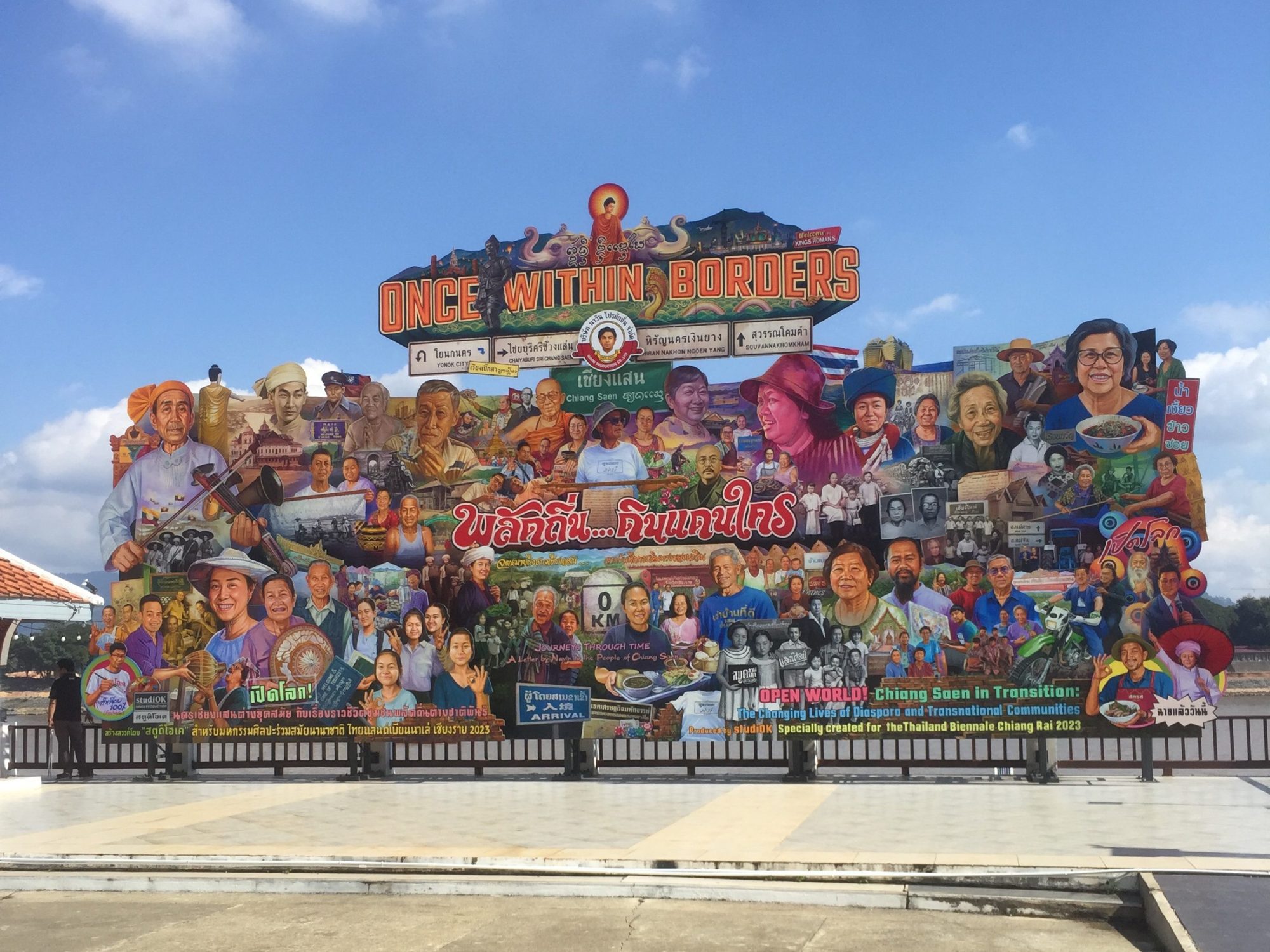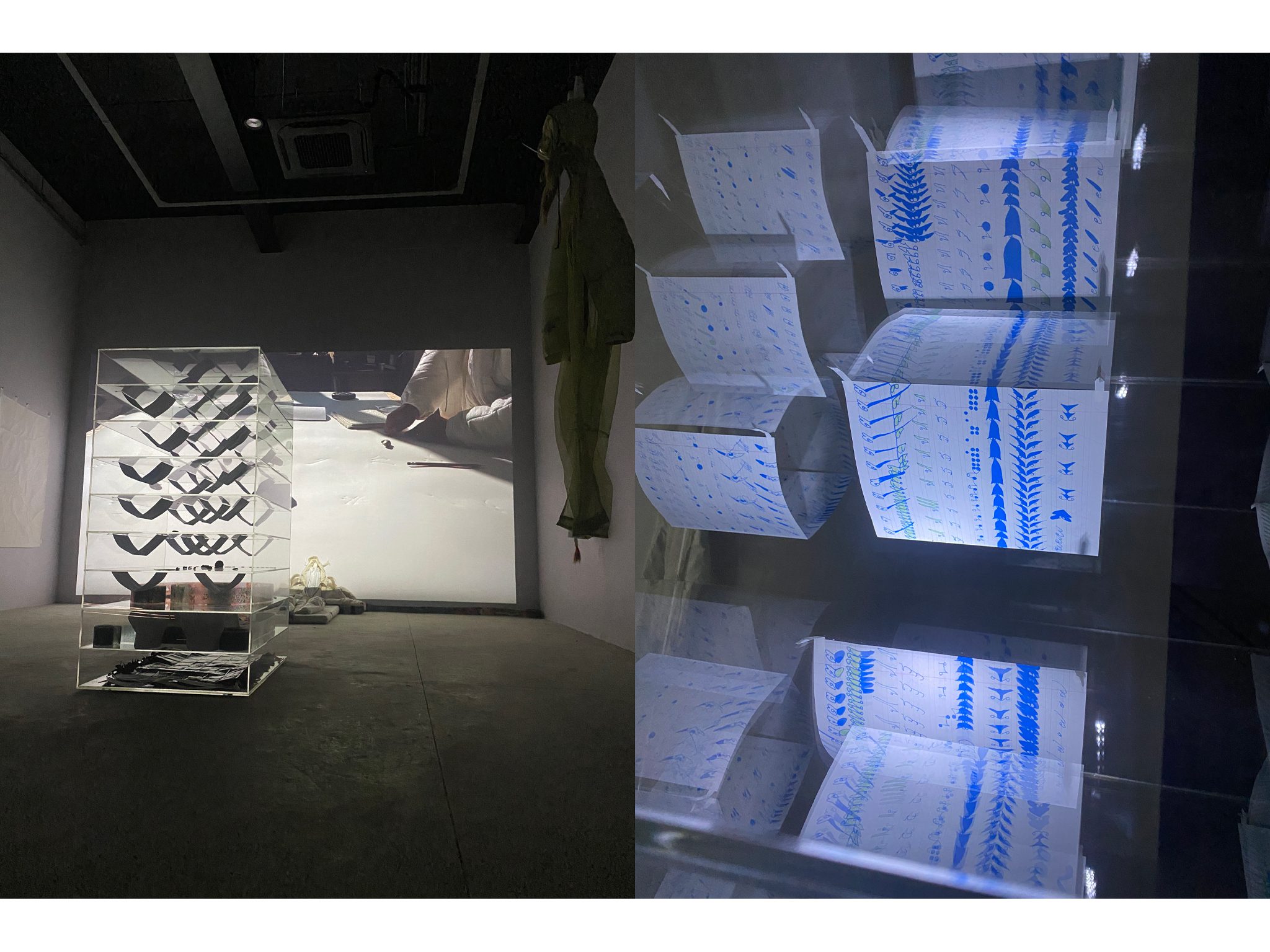THE INTERNATIONAL ART FESTIVAL UNDER THE THEME ‘OPEN WORLD,’ REPRESENTS THE HISTORIES AND STORIES OF EVERYDAY PEOPLE IN VARIOUS EXHIBITIONS ACROSS CHIANG RAI
TEXT: HOM SUKATO
PHOTO: HOM SUKATO EXCEPT AS NOTED
(For Thai, press here)
‘Open’ up the ‘world’ of micro-histories and stories of everyday people in Chiang Rai at Thailand Biennale Chiang Rai 2023—learn from the past to strive towards an envisioned, better future.
The curtain rose on the Thailand Biennale Chiang Rai 2023, an international art festival, on December 9th, marking the inception of its third edition following successful showcases in Krabi and Korat. Under the thought-provoking theme ‘The Open World’, this installment finds its inspiration in the open-world concept illustrated by a sculpture at Wat Pa Sak Muang in Chiang Saen, situated within Thailand’s Chiang Rai province. Beyond its representation of wisdom and enlightenment, the sculpture establishes a nuanced link with the contemporary understanding of the open world in the context of video games, where players revel in the liberty to approach and fulfill objectives through diverse avenues. This concept is rooted in the curatorial team’s vision to unveil a multi-dimensional, non-linear exhibition structure that defies the confines of conventional linear storytelling.
The scale of the Thailand Biennale Chiang Rai 2023 is expansive, encompassing both its geographical reach and content that reflects the region’s context. The event extends beyond the city limits of Chiang Rai, featuring primary exhibitions dispersed across various districts. There are over 10 pavilions showcasing the works of more than 60 artists, representing 21 countries. The pavilions, colloquially referred to as ‘sub-exhibitions,’ take place alongside parallel activities, including studio visits hosted by local artists. Scheduled to run until April 30, the event is the result of collaborative efforts from a team of four Thai curators: Rirkrit Tiravanija, Gridthiya Gaweewong, Angkrit Ajchariyasophon, and Manuporn Luengaram, with the first two being proud natives of Chiang Rai. Given the extensive array of artworks on display, fully appreciating each piece in a single visit may pose a challenge. For those planning to attend, our recommendation is to allocate at least a week for a truly immersive and comprehensive experience.
The origins of the exhibition’s central theme are revealed after embarking on a journey back to the ancient city of Chiang Saen and the Wat Pa Sak Historical Site, where the iconic open-world Buddha statue resides. Artist Chitti Kasemkitvatana meticulously intertwines archaeological elements and the history of Buddhism, the universe, and the physical realm of our world through dedicated artistic research and installation. In simpler terms, Kasemkitvatana distills the intricate dimensions of Chiang Saen, inviting viewers to explore them through the form of a triumphant drum. Crafted from metal, one side of the drum features a bas-relief of Kala’s face, the ancient creature known for consuming even its own lower jaw—a powerful symbol of ‘time’ devouring everything. On the other side, a mosaic of texts describes the physical world in 12 languages spoken by the ethnic groups residing in Chiang Saen.

Kala Ensemble. 2023. Chitti Kasemkitvatana.
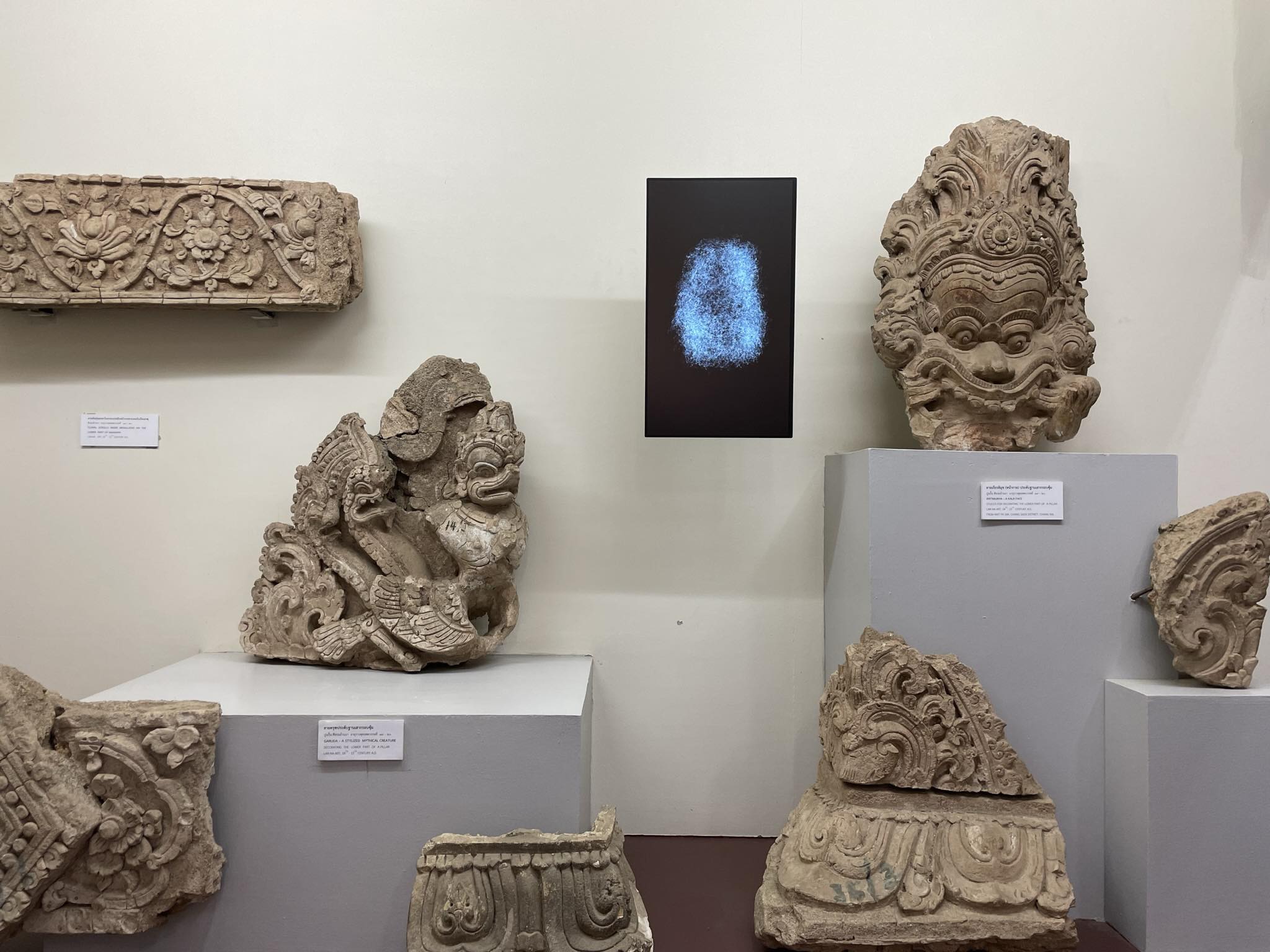
Kala Ensemble. 2023. Chitti Kasemkitvatana.
‘Baan Noorg Collaborative Arts and Culture’ recounts the tale of Taiyuan, one of the ethnic groups that once inhabited Chiang Saen, and the forced movement 200 years ago that resulted in the scattering of the Taiyuan people throughout the country. Situated at Ancient Monument No. 16 in Chiang Saen, the work takes the form of a black balloon shaped like a Chedi, reminiscent of something from 3D modeling software. At regular intervals, the fans supplying air to the balloon are set to cease operation, causing the structure to gracefully deflate. Not too far away, another installation reveals itself as a black rubber raft, inviting viewers to sit and recline. The weight of those on board causes the raft to produce resonant echoes through an internal microphone.
Both temporary installations rely on compressed air for their existence, featuring hollow structures with delicate fabric outer shells. Their perpetual rising and falling symbolizes the enduring cycle of marginalized cultures, preserved through adaptation to the ever-changing environment and the passage of time. The balloon Chedi and rubber raft, designed in forms speculated to have existed in the area’s past, serve as powerful symbols, embodying the imagined return of Taiyuan to the place they once called home—a poignant narrative existing solely in the realm of imagination.
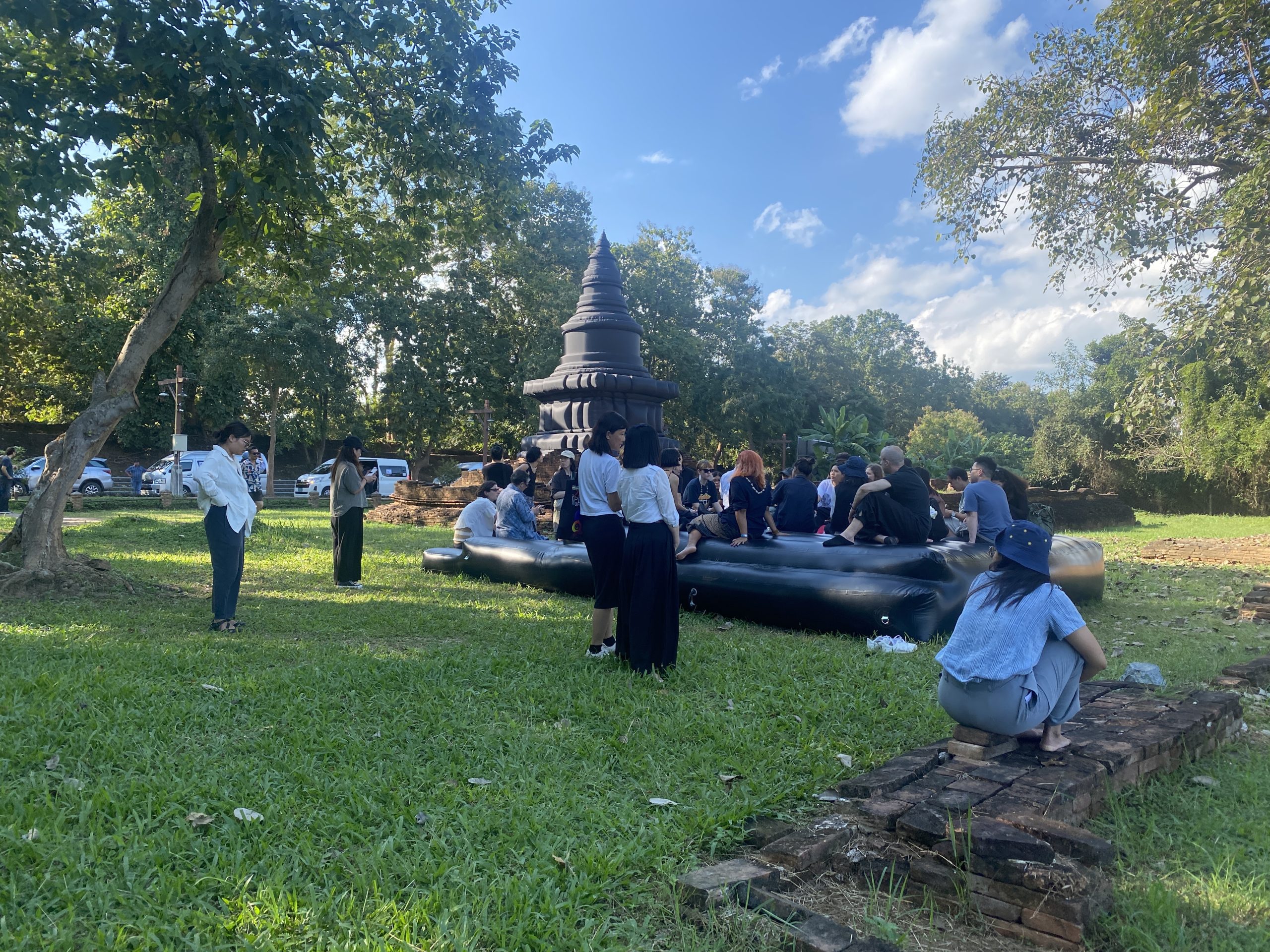
Taiyuan Return: On Transmission and Inheritance. 2023. Baan Noorg Collaborative Arts and Culture.
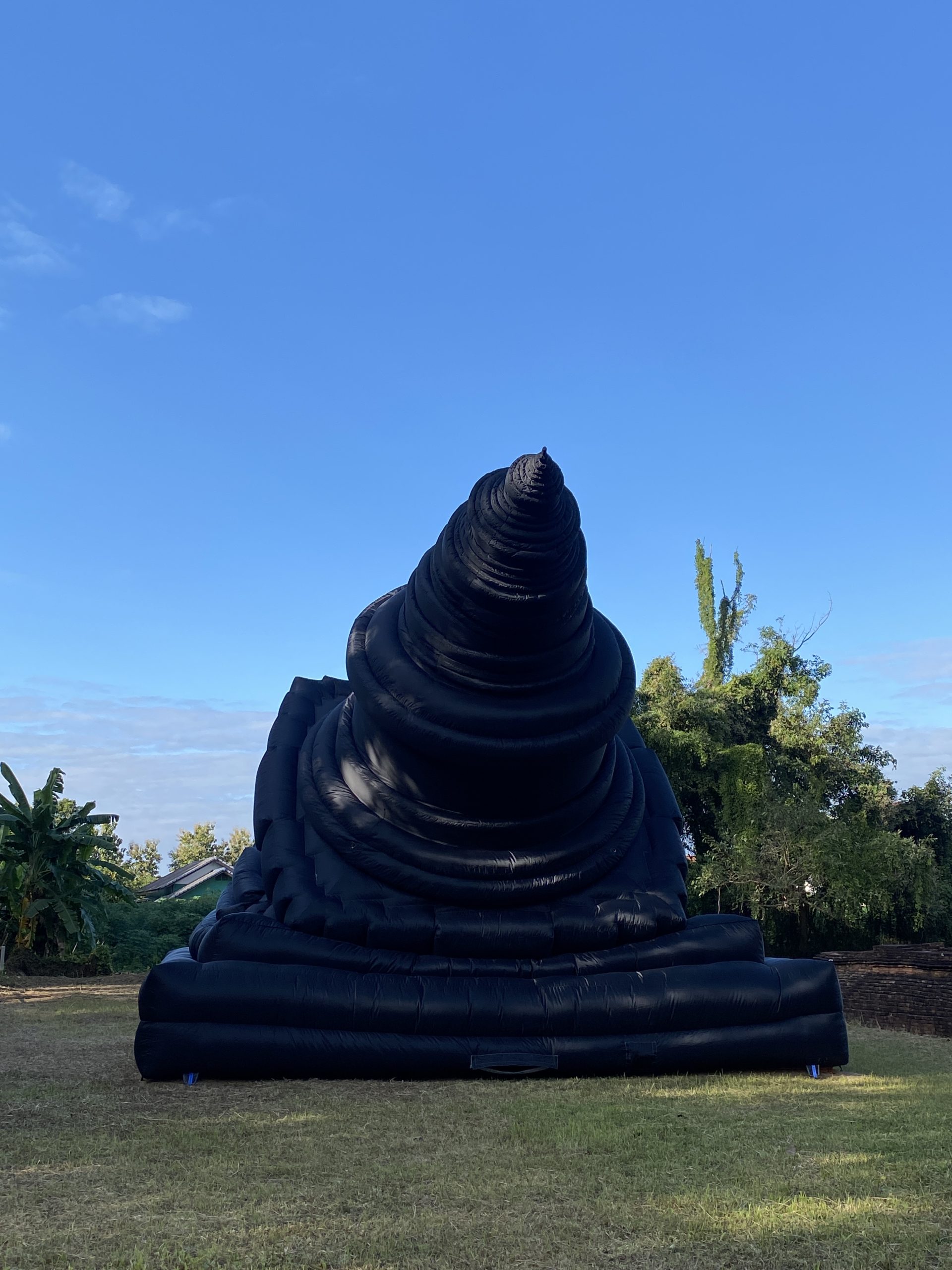
Taiyuan Return: On Transmission and Inheritance. 2023. Baan Noorg Collaborative Arts and Culture.
The identity of Chiang Saen is not solely derived from its past. A piece by Taiwanese artist Hsu Chia-Wei, displayed in the area where the borders of Thailand, Laos, and Myanmar (Burma) converge, explores the complex histories of Chiang Saen, portraying it not only as a city on the opium trade route in the past but also as a thriving port with influences from global capital in the present. To make the work more digestible for viewers, the artist chooses to digitize the stories and knowledge acquired from the House of Opium Museum, encompassing the broader context of the Golden Triangle. Employing rap music and versatile characters capable of embodying anyone in the narrative, Hsu Chia-Wei crafts an engaging storytelling experience that begins with an attention-grabbing intro: “I am an actor.” The Wiang Digital Community Center in Tambon Wiang, Chiang Saen, is selected as the exhibition venue. Here, the space undergoes a transformation with red-tinted, laminated mirrors, creating an atmosphere that blurs the line between reality and illusion. The artist alters the screensavers on the center’s computers, replacing them with images of vibrant opium poppies. Additionally, visitors can catch a glimpse of Kings Roman, the influential Chinese-owned casino empire on the Laotian side, from within the building.
On a billboard on the Thai side of the Golden Triangle, Navin Rawanchaikul painted a lively illustration of the residents of Chiang Rai, including the four curators. On the opening day, the artist hosted a screening session of a documentary film about the diverse ethnic groups residing in the area, sparking meaningful discussions about land ownership in the region and the necessity of borders. All of these events unfold against the backdrop of a bustling local market offering an incredible array of food, snacks, and beverages, attracting people who have journeyed from different locations alongside the local residents and vendors who call the place home. The artwork has created a dynamic platform that welcomes both outsiders and locals, fostering a sense of unity and diversity.

The Actor from Golden Triangle. 2023. Hsu Chia-Wei.
When it comes to the discussion about extraordinary works through an anthropological lens, one cannot dismiss those centered on environmental narratives. At the Mekong Basin Civilization Museum, nestled within Mae Fah Luang University, the displayed pieces intricately intertwine with the area’s distinct cultural, societal and cultural backgrounds, harmonizing with the museum’s thematic focus. A long-duration performance by Wit Pimkanchanapong, arising from his leisurely long-distance kayaking, rightfully claims the spotlight. The artist traversed the Mekong River, embarking on a 300-kilometer journey from Chiang Khong to Luang Prabang, with a 10-day encampment along the riverbanks. All this unfolded against the ominous backdrop of certain river stretches potentially succumbing to blockades due to the current and imminent construction of multiple dams. Wit’s exploration and meticulous documentation of this expedition illuminate the challenges posed by dam construction and electricity generation, unraveling their impacts on the environment and contribution to air pollution. The artist poetically refers to the resulting charcoal debris as ‘black butterflies.’ Reading and seeing the photographs induces a peculiarly enchanting, almost romantic sentiment.

Summer Holiday with Naga. 2019. Wit Pimkanchanapong.
Another artwork serving as a ‘voice’ for the environment is situated in the Mae Fah Luang Art and Cultural Park. Nguyen Trinh Thi drew inspiration for the piece from environmental protection initiatives that aim to shield the Mekong River ecosystem from the negative effects of hydroelectric dam construction. The Mekong River’s flowing currents orchestrate the live performance inside the auditorium. At the river learning center in Chiang Khong district called ‘Hong Hien Mae Nam,’ sensors, underwater microphones, and Wi-Fi systems are installed to send signals to traditional musical instruments that are placed next to ancient Lanna artifacts like ‘Sattaphan’ (an ancient altar used for placing candles in northern temples) and ‘Toong Kran Dang’ (an ornamental fabric used to decorate during religious ceremonies in the northern region). The instruments play automatically, creating a composition from the endless streams of the Mekong River. The performance serves as a poignant reminder of the losses incurred behind the façade of development.

Summer Holiday with Naga. 2019. Wit Pimkanchanapong.
The exhibition space that may demand the most time for exploration is the Chiang Rai International Art Museum (CIAM). Unlike many works featured in this biennale, the pieces in this gallery aren’t exclusively site-specific. Housed inside the museum’s large building with expansive exhibition areas are works by international artists. Upon entering the white cube exhibition room, an environment that typically signifies an ordinary art space, one is immediately struck with a unique and distinctive experience. In the dimly lit rooms, spectators are encouraged to use flashlights to observe the works of Mongolian artist Tuguldur Yondonjamts. It’s as though one is delving into the artist’s intrinsic nature through the intricacies of the displayed artwork. At this point, viewers would probably gain a better understanding of the artist’s efforts to explore, or even comprehend, the context of Chiang Rai within the limited timeframe provided.
Tuguldur’s fascination with the concept of warmth was inspired by his initial visit to Chiang Rai. This concept weaves into the artist’s fictional narrative about the Antarctic research base on Livingston Island that invited Mongolian scientists for research. The drawings on paper, resembling Cyrillic letters in overlapping acrylic boxes, metaphorically convey melting ice due to warm temperatures (portions of the work are given to viewers as souvenirs).

My Bulgarian Neighbor. 2023. Tuguldur Yondonjamts.
While some works may not adopt site-specific forms, they are curated in a manner that takes into account their connection to the festival’s central theme. For instance, the video installation discreetly positioned in the deepest corner of the ground-floor room offers viewers a glimpse into the future after it has evolved into the past. Xin Liu, an artist and engineer, tells the story of the history of the future world and the pursuit of rocket fragments. This narrative unfolds through the perspective of a character who journeys from villages to deserts in search of an object referred to as the ‘white stone.’ The arrival of extraterrestrial objects not only triggers tremors and alters the landscape but also influences the minds of scientists and the beliefs of local people. The artist guides us, the viewers, to explore the lifecycle of technology that ultimately returns and ‘dies’ on Earth.
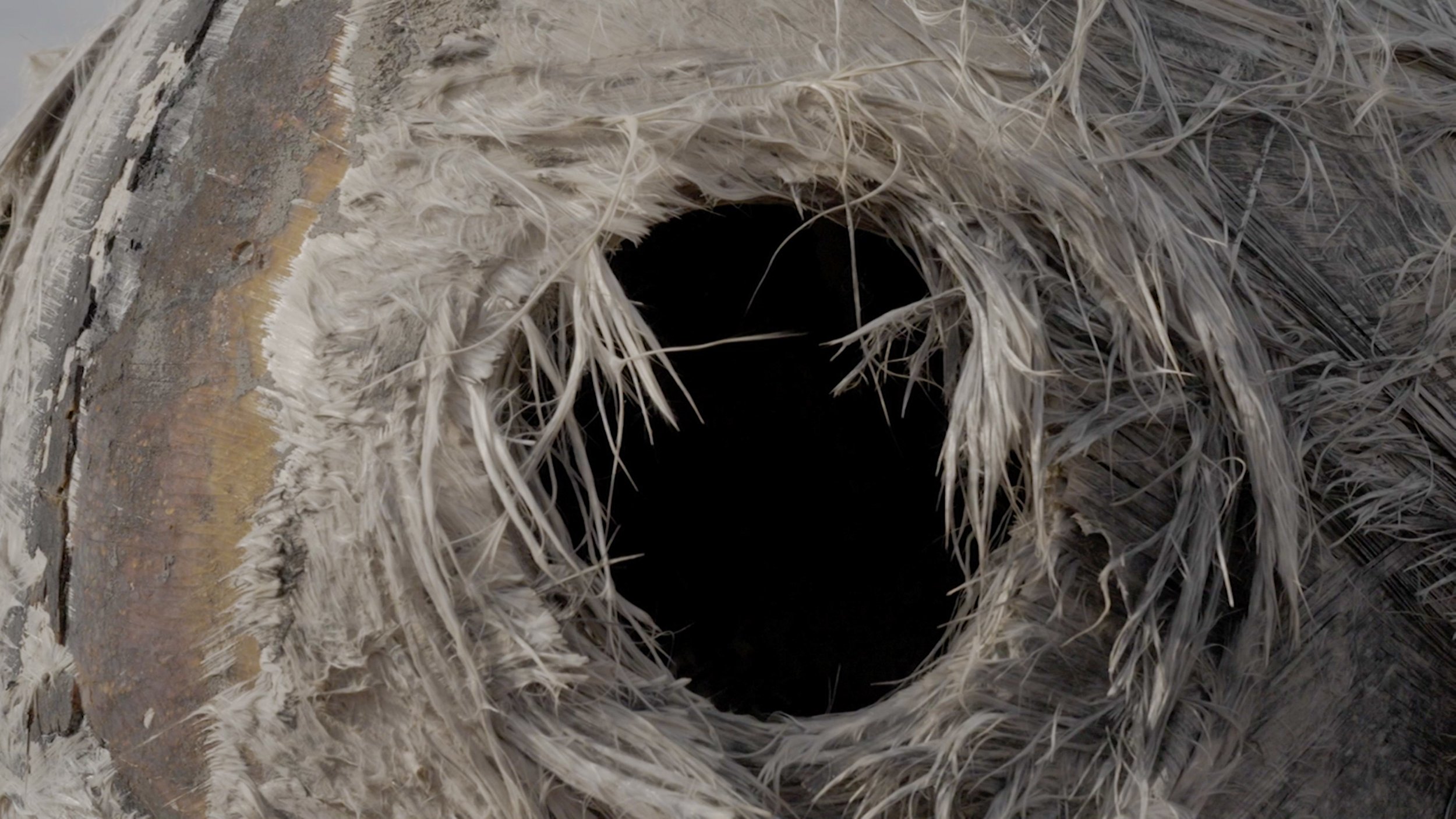
The White Stone. 2021. Xin Liu. | Photo courtesy of the artist and Make Room, Los Angeles
Reflecting on the ‘Open World’ theme, perhaps there’s no need for an exhaustive interpretation. Simplify it; take it literally—open your eyes, open your ears, and embrace what Thailand Biennale Chiang Rai 2023 has to offer.


